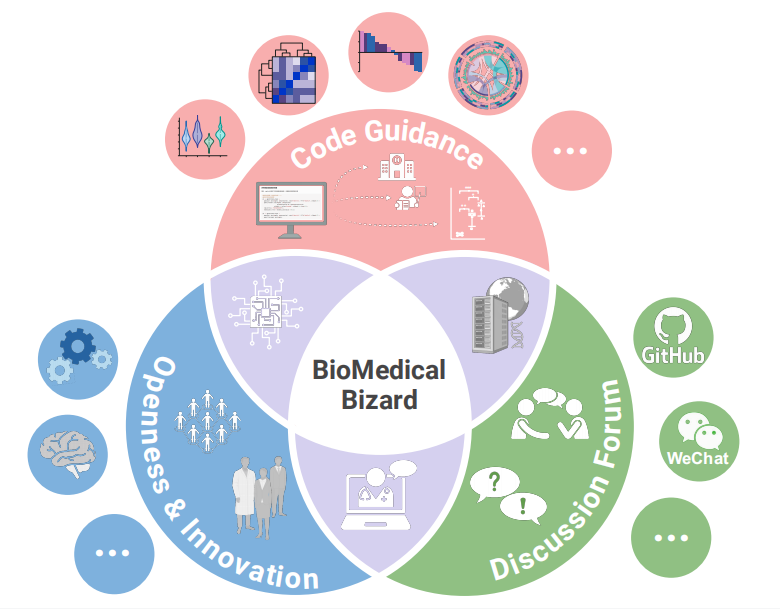# Install packages
if (!requireNamespace("sf", quietly = TRUE)) {
install.packages("sf")
}
if (!requireNamespace("rnaturalearth", quietly = TRUE)) {
install.packages("rnaturalearth")
}
if (!requireNamespace("rnaturalearthdata", quietly = TRUE)) {
install.packages("rnaturalearthdata")
}
if (!requireNamespace("gstat", quietly = TRUE)) {
install.packages("gstat")
}
if (!requireNamespace("dplyr", quietly = TRUE)) {
install.packages("dplyr")
}
if (!requireNamespace("ggplot2", quietly = TRUE)) {
install.packages("ggplot2")
}
if (!requireNamespace("ggspatial", quietly = TRUE)) {
install.packages("ggspatial")
}
if (!requireNamespace("ggnewscale", quietly = TRUE)) {
install.packages("ggnewscale")
}
if (!requireNamespace("ggrepel", quietly = TRUE)) {
install.packages("ggrepel")
}
if (!requireNamespace("ggfx", quietly = TRUE)) {
install.packages("ggfx")
}
if (!requireNamespace("doParallel", quietly = TRUE)) {
install.packages("doParallel")
}
if (!requireNamespace("viridis", quietly = TRUE)) {
install.packages("viridis")
}
# Load packages
library(sf)
library(rnaturalearth)
library(rnaturalearthdata)
library(gstat)
library(dplyr)
library(ggplot2)
library(ggspatial)
library(ggnewscale)
library(ggrepel)
library(ggfx)
library(doParallel)
library(viridis)Population Map Plot
Example
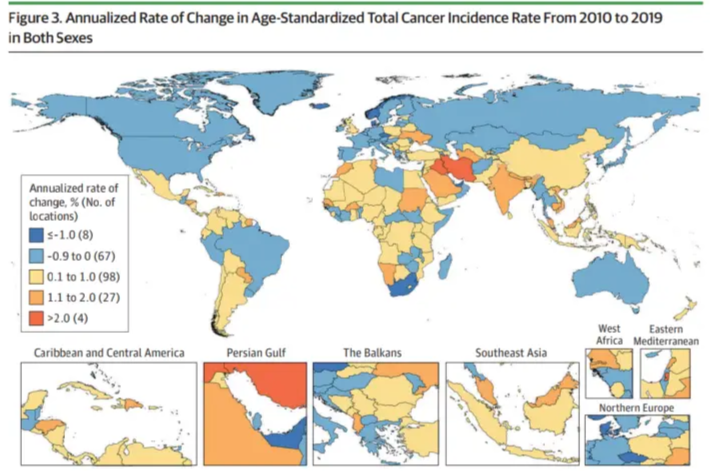
Shows the geographical distribution of disease incidence, with light and dark colors indicating higher and lower incidence rates, and map boundaries representing administrative divisions.
Setup
System Requirements: Cross-platform (Linux/MacOS/Windows)
Programming language: R
Dependent packages:
sf;rnaturalearth;rnaturalearthdata;gstat;dplyr;ggplot2;ggspatial;ggnewscale;ggrepel;ggfx;doParallel;viridis
Data Preparation
# Global geographic data
world <- ne_countries(scale = "medium", returnclass = "sf")
# Simulating epidemiological data
set.seed(123)
world$incidence <- runif(nrow(world), 0, 100) # Randomly generate incidence dataVisualization
1. Basic Plot
# Basic map of global disease incidence distribution
p1 <- ggplot(data = world) +
geom_sf(aes(fill = incidence)) +
scale_fill_viridis(option = "C") +
labs(title = "Global Disease Incidence",
fill = "Incidence Rate\n(per 100k)")
p1
Key parameter analysis: binwidth / bins aes(fill): Define color maps for epidemiological indicators
scale_fill_viridis(): Use accessible color gradients
ne_countries(): The scale parameter controls the map’s level of detail.(small/medium/large)
# Customized epidemiological maps
p2 <- ggplot(data = world) +
geom_sf(aes(fill = incidence), color = "white", size = 0.2) +
scale_fill_gradientn(colors = c("#2c7bb6", "#abd9e9", "#ffffbf", "#fdae61", "#d7191c"),
breaks = c(20, 40, 60, 80)) +
# scale
annotation_scale(
location = "bl",
plot_unit = "km",
style = "ticks",
width_hint = 0.1
) +
# Compass (after restoration)
annotation_north_arrow(
location = "tr",
which_north = "grid", # Use Grid North
style = north_arrow_minimal(
line_width = 1,
text_size = 10
),
pad_x = unit(1.2, "cm"),
pad_y = unit(1.2, "cm")
) +
coord_sf(crs = "+proj=robin",
xlim = c(-1.6e7, 1.6e7),
ylim = c(-7.5e6, 8.5e6),
expand = FALSE) + # Use Robinson projection
theme_void() +
guides(fill = guide_colorbar(barwidth = 1)) +
labs(fill = "Incidence Rate")+
theme(
legend.position = c(0.1, 0.3) # Relative position coordinates (the lower left corner is 0,0)
)
p2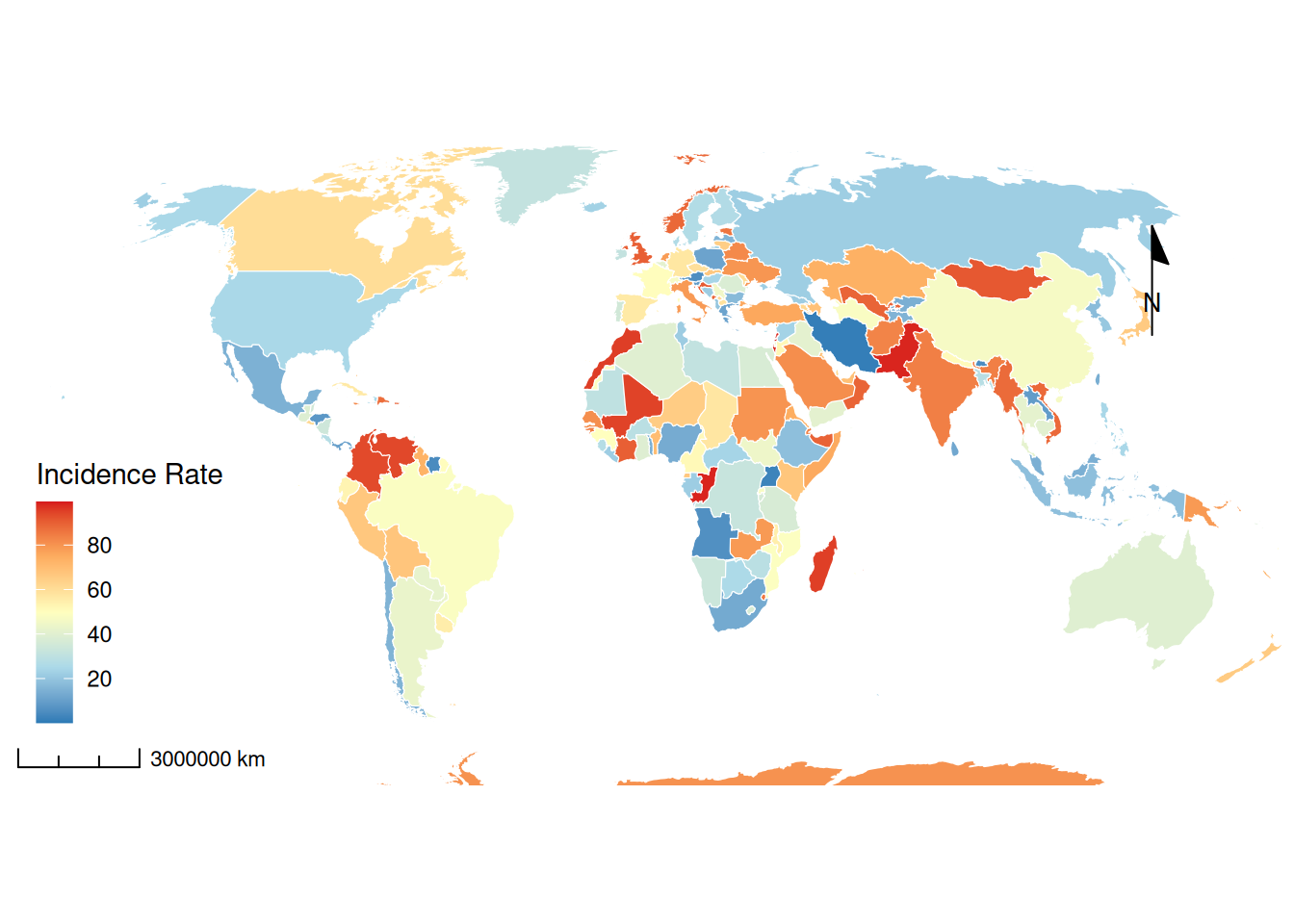
2. Advanced plot
# Advanced plot
# Further process the data and use spatial points to infer the situation of nearby surfaces
# Reduce calculation time, the fewer points below, the closer the estimated distance, the higher the resolution, and the more accurate it is
# Parallel initialization
registerDoParallel(cores = 4)
# Data Preparation
world_proj <- st_transform(world, "+proj=eqc +units=m")
centroids <- st_centroid(world_proj) %>%
dplyr::select(incidence)
# Create a low-resolution grid (100x100)
grid <- st_make_grid(world_proj, n = c(100,100)) %>%
st_as_sf() %>%
st_join(world_proj, join = st_intersects)
# Variogram model optimization
variogram_model <- vgm(
psill = 30,
model = "Exp", # Switch to an exponential model
range = 2e6, # 2000 km related range
nugget = 5
)
# Block parallel computing
grid_chunks <- split(grid, cut(st_coordinates(st_centroid(grid))[,1], 4))
krige_result <- foreach(i=1:4, .combine=rbind) %dopar% {
krige(incidence ~ 1,
locations = centroids,
newdata = grid_chunks[[i]],
model = variogram_model,
nmax = 30)
} %>% st_as_sf()
# Convert back to WGS84 coordinate system
krige_result <- st_transform(krige_result, 4326)
advanced_map <- ggplot() +
# Spatially interpolated surfaces
geom_sf(data = krige_result,
aes(fill = var1.pred, color = var1.pred),
alpha = 0.6) +
scale_fill_gradientn(
colors = c("#2c7bb6", "#abd9e9", "#ffffbf", "#fdae61", "#d7191c"),
name = "Interpolated\nIncidence"
) +
scale_color_gradientn(
colors = c("#2c7bb6", "#abd9e9", "#ffffbf", "#fdae61", "#d7191c"),
guide = "none"
) +
ggnewscale::new_scale_fill() +
# Original national borders
geom_sf(data = world,
aes(fill = incidence),
color = "white",
size = 0.1,
alpha = 0.5) +
scale_fill_gradientn(
colors = c("#2c7bb6", "#abd9e9", "#ffffbf", "#fdae61", "#d7191c"),
name = "Country\nIncidence",
breaks = seq(0, 100, 20)
) +
# 3D relief effect
ggfx::with_shadow(
geom_sf(data = world,
aes(geometry = geometry),
color = "grey30",
fill = NA,
size = 0.2),
sigma = 5,
x_offset = 3,
y_offset = 3
) +
# Hotspot annotation
geom_sf(data = world %>% filter(incidence > quantile(incidence, 0.9)),
color = "red",
fill = NA,
size = 0.5) +
ggrepel::geom_label_repel(
data = world %>% filter(incidence > quantile(incidence, 0.9)),
aes(label = name, geometry = geometry),
stat = "sf_coordinates",
size = 2.5,
box.padding = 0.2,
min.segment.length = 0,
fill = alpha("white", 0.8)
) +
# Map elements
annotation_north_arrow(
location = "tr",
width = unit(1.2, "cm"), # New width parameter
height = unit(1.2, "cm"), # Added height parameter
style = north_arrow_minimal() # Remove size parameters
) +
# Coordinate projection
coord_sf(crs = "+proj=robin") +
# Theme Settings
theme_void() +
theme(
legend.position = c(0.12, 0.3),
legend.background = element_rect(fill = alpha("white", 0.8), color = NA),
plot.title = element_text(hjust = 0.5, face = "bold", size = 16),
panel.background = element_rect(fill = "#F0F8FF")
) +
labs(title = "Advanced Spatial Distribution of Disease Incidence")
advanced_map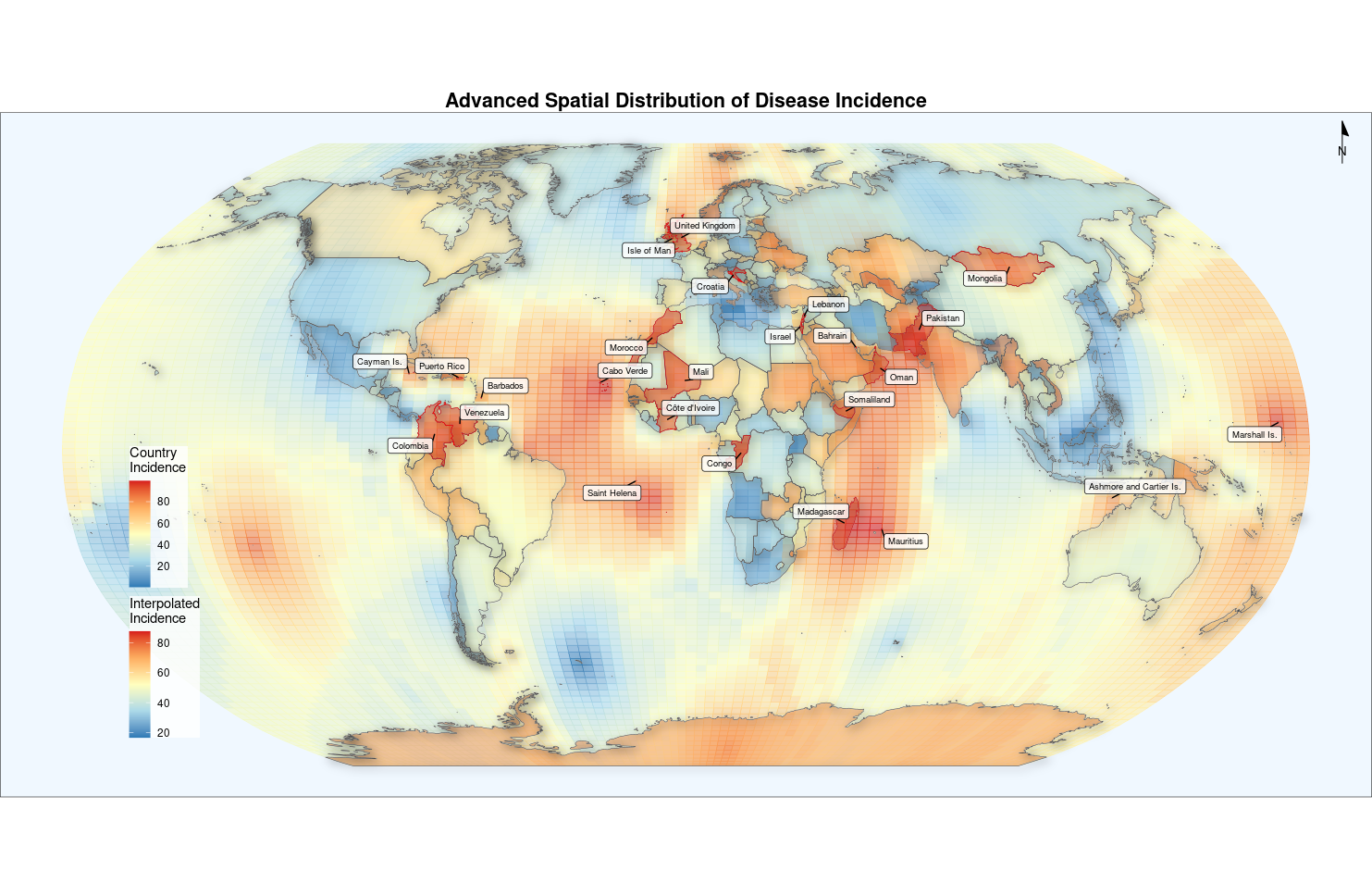
Optionally, you can use callout-tip to add a detailed description of the parameter if needed.
Application
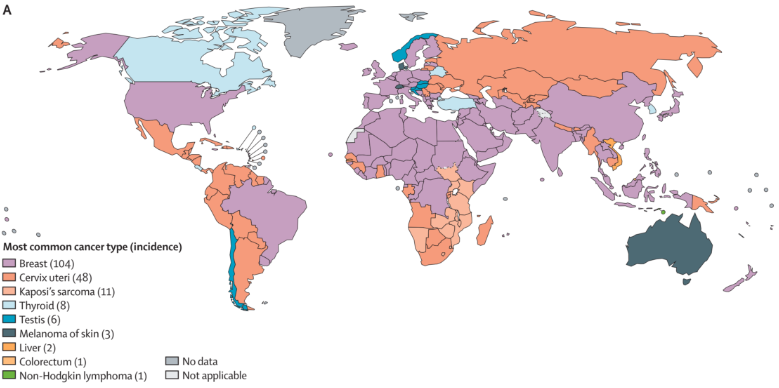
Population Map Application
This chart shows how common cancers vary across countries around the world. [1]
Reference
[1] Global Burden of Disease 2019 Cancer Collaboration; Kocarnik JM, Compton K, Dean FE, et al. Cancer Incidence, Mortality, Years of Life Lost, Years Lived With Disability, and Disability-Adjusted Life Years for 29 Cancer Groups From 2010 to 2019: A Systematic Analysis for the Global Burden of Disease Study 2019. JAMA Oncol. 2022;8(3):420-444. https://doi.org/10.1001/jamaoncol.2021.6987
[2] Fidler MM, Gupta S, Soerjomataram I, Ferlay J, Steliarova-Foucher E, Bray F. Cancer incidence and mortality among young adults aged 20-39 years worldwide in 2012: a population-based study. Lancet Oncol. 2017;18(12):1579-1589. https://doi.org/10.1016/S1470-2045(17)30677-0
[3] Wickham H, Chang W, Henry L, et al. ggplot2: Create Elegant Data Visualisations Using the Grammar of Graphics [Computer software]. (Version 3.4.0). 2022. https://ggplot2.tidyverse.org/reference/ggsf.html
